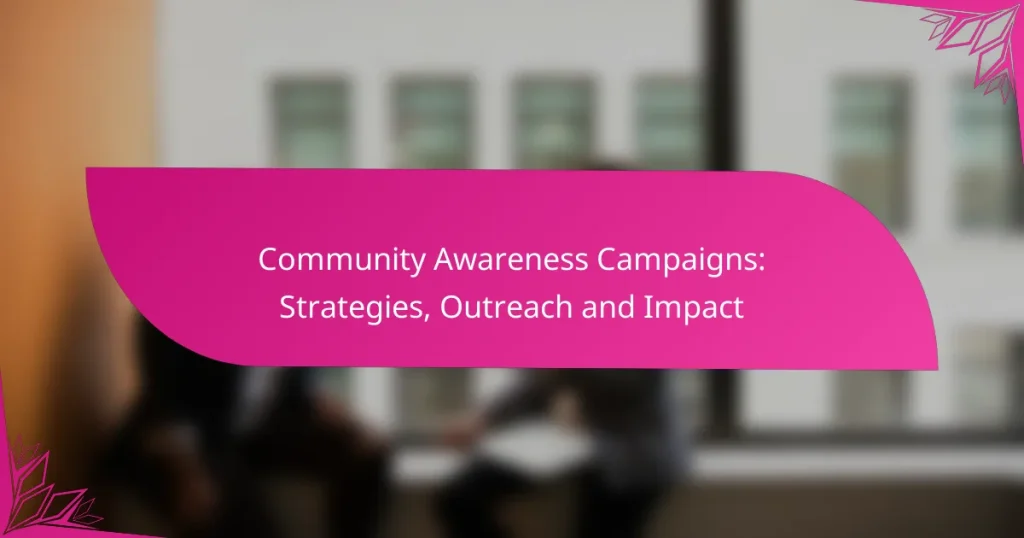Community awareness campaigns play a crucial role in fostering engagement and driving social change. By employing effective strategies such as leveraging social media, forming local partnerships, and hosting interactive events, these campaigns can significantly enhance outreach and impact. Measuring success through metrics like engagement rates and participant feedback allows for continuous improvement and greater resonance with the target audience.
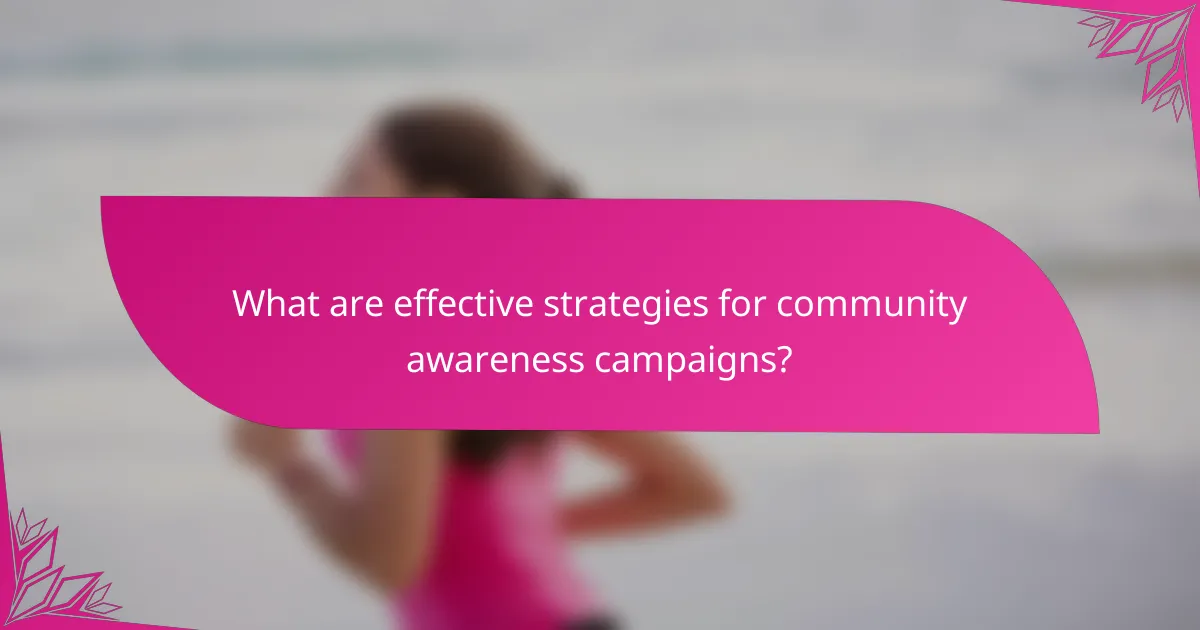
What are effective strategies for community awareness campaigns?
Effective strategies for community awareness campaigns include leveraging social media, forming partnerships with local organizations, and hosting interactive events. These approaches enhance outreach and engagement, ensuring that the campaign resonates with the target audience.
Social media engagement
Social media engagement is crucial for reaching a broad audience quickly and cost-effectively. Platforms like Facebook, Instagram, and Twitter allow for real-time interaction and feedback, making it easier to gauge community interest and adjust messaging accordingly.
To maximize impact, create shareable content such as infographics, videos, and polls that encourage participation. Regularly update followers with campaign progress and success stories to maintain interest and momentum.
Partnerships with local organizations
Forming partnerships with local organizations can amplify the reach of community awareness campaigns. Collaborating with schools, non-profits, and businesses allows for resource sharing and access to established networks.
Consider co-hosting events or workshops that align with both organizations’ missions. This not only strengthens community ties but also enhances credibility and trust among participants.
Interactive workshops and events
Hosting interactive workshops and events fosters direct engagement and allows community members to participate actively. These gatherings can include discussions, hands-on activities, or demonstrations that relate to the campaign’s goals.
Plan events in accessible locations and at convenient times to encourage attendance. Providing incentives, such as refreshments or small giveaways, can further enhance participation and enthusiasm.
Utilizing local influencers
Local influencers can significantly boost the visibility of community awareness campaigns. These individuals often have established trust and rapport with their followers, making them effective advocates for your cause.
Identify influencers who align with your campaign’s values and message. Collaborate with them to create authentic content that resonates with their audience, such as testimonials or behind-the-scenes looks at the campaign.
Targeted messaging for specific demographics
Targeted messaging ensures that community awareness campaigns effectively reach diverse demographic groups. Tailoring messages based on age, culture, and interests increases relevance and engagement.
Conduct surveys or focus groups to understand the specific needs and preferences of different community segments. Use this information to craft messages that speak directly to those groups, enhancing the likelihood of a positive response.
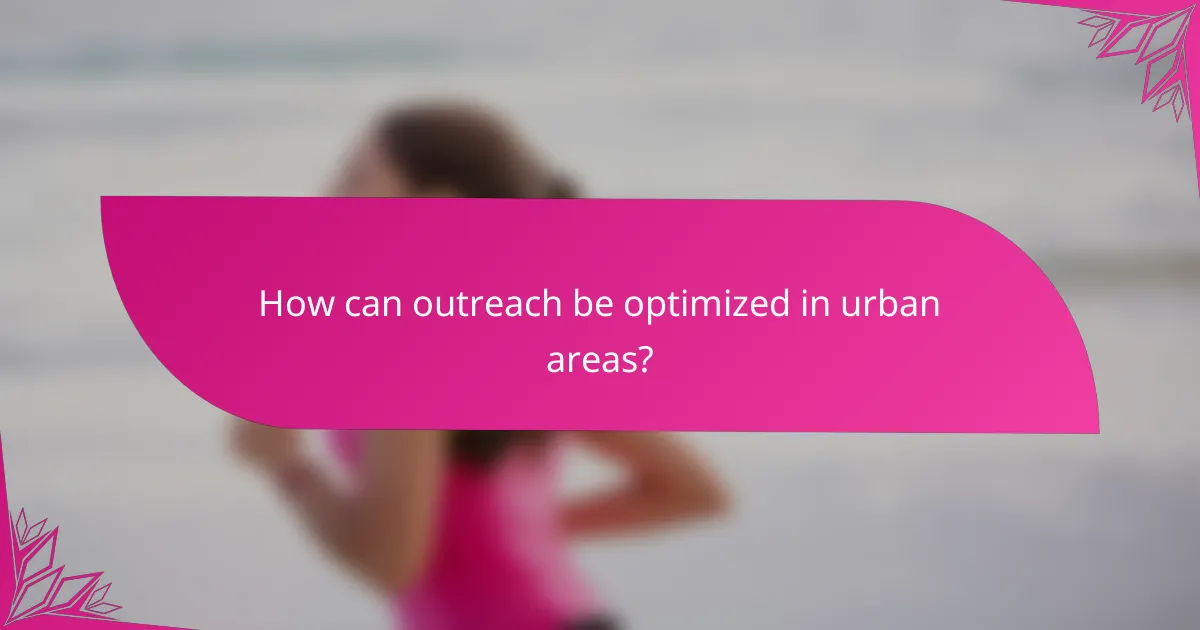
How can outreach be optimized in urban areas?
Outreach in urban areas can be optimized by focusing on community engagement strategies that leverage local resources and networks. Effective methods include utilizing community centers, door-to-door canvassing, and engaging with local media channels to reach diverse populations.
Leveraging community centers
Community centers serve as vital hubs for outreach in urban areas, providing a space where residents gather and participate in activities. Collaborating with these centers can enhance visibility and trust, making it easier to disseminate information about campaigns.
To effectively leverage community centers, consider hosting events or workshops that align with the interests of the local population. This could include health fairs, educational seminars, or cultural celebrations, which can attract a wide audience and facilitate meaningful interactions.
Door-to-door canvassing
Door-to-door canvassing is a direct method of outreach that allows for personal engagement with residents. This approach can be particularly effective in urban settings where diverse communities may have varying needs and concerns.
When implementing door-to-door canvassing, ensure that canvassers are well-trained and knowledgeable about the campaign’s goals. A friendly, respectful approach can foster positive relationships and encourage participation. Aim for areas with high foot traffic or community gatherings to maximize impact.
Utilizing local media channels
Local media channels, including newspapers, radio stations, and community blogs, play a crucial role in reaching urban populations. These platforms can help amplify the message of community awareness campaigns and engage residents who may not be reached through traditional methods.
To effectively utilize local media, develop strong relationships with journalists and content creators. Share press releases, success stories, and event announcements to encourage coverage. Consider advertising in local publications or sponsoring community radio segments to further enhance visibility.
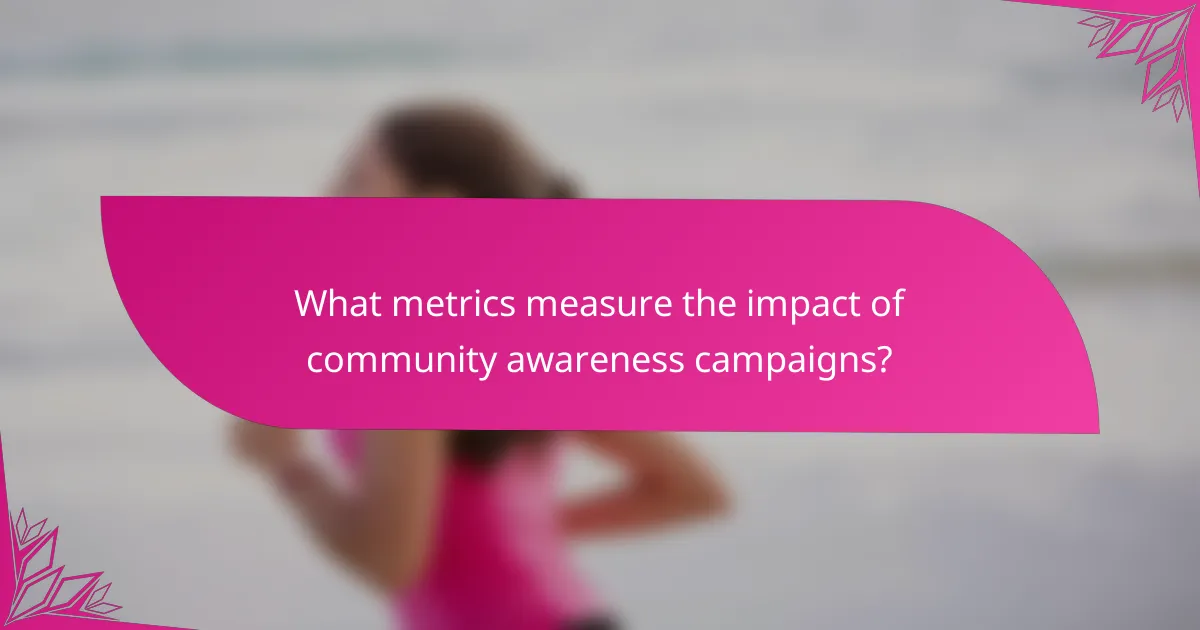
What metrics measure the impact of community awareness campaigns?
Metrics that measure the impact of community awareness campaigns include engagement rates on social media, attendance at events, survey feedback from participants, and increased community participation. These indicators help assess how effectively a campaign resonates with its target audience and drives desired actions.
Engagement rates on social media
Engagement rates on social media reflect how actively users interact with campaign content. This includes likes, shares, comments, and overall reach. A higher engagement rate, typically above 2-3%, indicates that the content is resonating with the audience.
To improve engagement, consider using compelling visuals and clear calls to action. Regularly monitor analytics to identify which posts perform best and adjust your strategy accordingly.
Attendance at events
Attendance at events is a direct measure of community interest and participation in awareness campaigns. Tracking the number of attendees at workshops, seminars, or community gatherings provides insight into the campaign’s effectiveness. Aim for a turnout that exceeds previous events by at least 20% to gauge growth.
To boost attendance, promote events through multiple channels, including social media, local newsletters, and community boards. Offering incentives, such as refreshments or giveaways, can also attract more participants.
Survey feedback from participants
Survey feedback from participants offers qualitative insights into the campaign’s impact. Collecting data on participants’ perceptions and experiences can reveal strengths and areas for improvement. Aim for a response rate of at least 30% to ensure the feedback is representative.
Design surveys with clear, concise questions and consider using a mix of rating scales and open-ended questions. Analyzing this feedback can help refine future campaigns and enhance community engagement.
Increased community participation
Increased community participation indicates a successful awareness campaign, as it shows that more individuals are taking action based on the campaign’s messaging. This can be measured through the number of volunteers, participants in community programs, or involvement in local initiatives.
To foster greater participation, create opportunities for community members to engage actively. This could include volunteer programs, collaborative projects, or partnerships with local organizations. Tracking participation trends over time can help assess the long-term impact of your campaigns.

What are the prerequisites for launching a successful campaign?
Launching a successful community awareness campaign requires a clear understanding of the target audience, defined objectives, and a committed team. These prerequisites ensure that the campaign is relevant, measurable, and effectively executed.
Understanding community needs
To effectively address community needs, conduct surveys, focus groups, or interviews to gather insights. This information helps identify the specific issues or interests that resonate with the community, allowing for tailored messaging.
Consider demographic factors such as age, income, and education level, as these can influence how the community perceives and engages with your campaign. Regularly updating this understanding is crucial, as community needs can evolve over time.
Establishing clear goals
Clear goals provide direction and a framework for measuring success. Goals should be specific, measurable, achievable, relevant, and time-bound (SMART). For example, aiming to increase participation in local health screenings by 25% within six months is a clear and actionable goal.
Establishing both short-term and long-term goals can help maintain momentum and focus. Short-term goals can serve as milestones that lead to the achievement of broader objectives, enhancing overall campaign effectiveness.
Building a dedicated team
A dedicated team is essential for the successful execution of a campaign. Assemble individuals with diverse skills, including marketing, community outreach, and project management, to cover all aspects of the campaign effectively.
Encourage team collaboration and communication to foster a shared vision and commitment. Regular meetings and updates can help keep everyone aligned and motivated throughout the campaign’s duration.
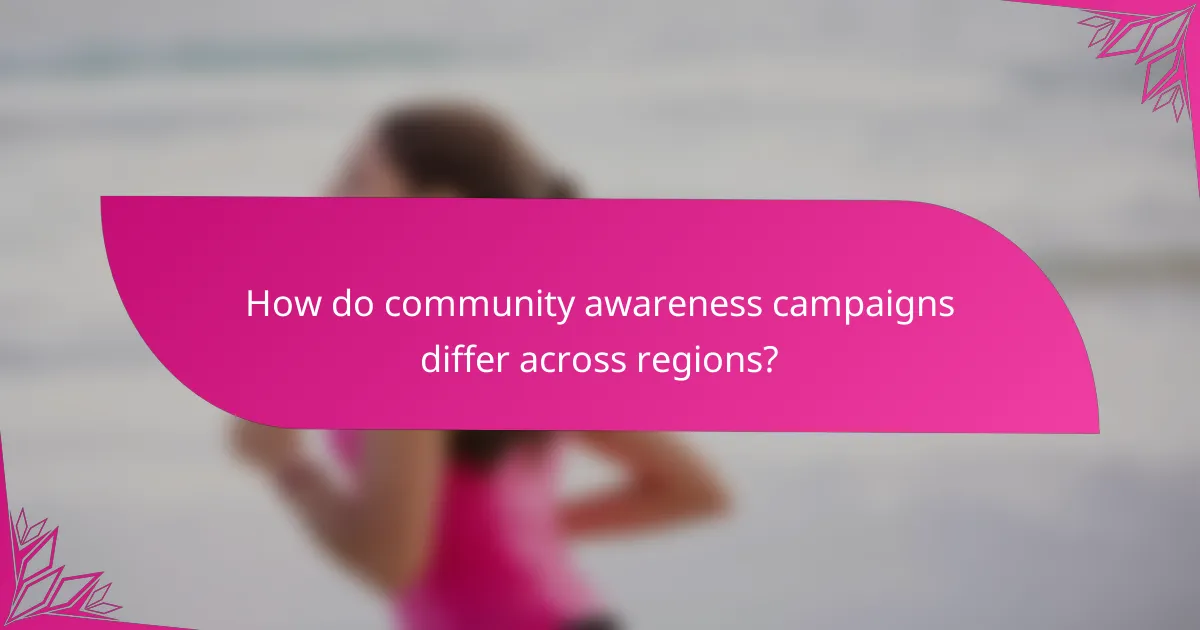
How do community awareness campaigns differ across regions?
Community awareness campaigns vary significantly across regions due to cultural, economic, and social factors. These differences influence the strategies employed, the outreach methods used, and the overall impact of the campaigns.
Urban vs. rural outreach strategies
Urban outreach strategies often leverage digital platforms and social media to reach a diverse audience quickly. Campaigns may include targeted ads, influencer partnerships, and community events in public spaces, maximizing visibility in densely populated areas.
In contrast, rural outreach strategies tend to focus on face-to-face interactions and local media. Community meetings, flyers, and collaborations with local organizations are effective in engaging residents who may have limited internet access. Understanding the local culture and community dynamics is crucial for success in these areas.
When planning outreach, consider the unique characteristics of the target audience. Urban campaigns might prioritize speed and reach, while rural efforts should emphasize trust and personal connections. Tailoring the approach to fit the regional context can significantly enhance campaign effectiveness.
